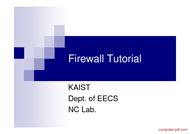Firewall Tutorial for Beginners in PDF
Contents
- What is Firewalls?
- Why Firewalls?
- Types of Firewalls
- Limitations of firewalls and gateways
- Firewalls in Linux
Learning the Firewall Tutorial
A firewall is a security system that checks incoming and outgoing network traffic and controls it based on security rules and policies that have already been set. It acts as a barrier between a private internal network and the public Internet, protecting the network and its users against malicious activities such as cyberattacks, hacking, and data theft.
Several types of firewalls include network firewalls, host-based firewalls, and application-based firewalls.
Network firewalls, also known as packet filters, operate at the network layer of the OSI (Open Systems Interconnection) model. They use security rules to filter network traffic based on IP address, port number, and protocol. For example, a rule can be established only to allow HTTP traffic (port 80) from trusted IP addresses and block all other traffic. Network firewalls are typically hardware-based and are placed at the perimeter of a network to protect it from external threats. They are effective in controlling access to a network and preventing unauthorized access.
Host-based firewalls, on the other hand, are software-based and installed on individual host computers. They protect individual systems by monitoring and controlling incoming and outgoing network traffic. Host-based firewalls can protect personal computers, laptops, and other mobile devices from network-based attacks. They also allow for creation of security rules and policies specific to each system, providing additional protection for sensitive data and applications.
Application-based firewalls, also called proxy firewalls, work at the OSI model's application layer. They filter traffic based on the requested application or service, such as HTTP or FTP. Application-based firewalls provide an extra layer of security by inspecting incoming and outgoing traffic content, allowing only authorized traffic to pass through. They can also block traffic from known malicious websites or prevent the execution of malware.
In addition to the basic firewall functions, many firewalls include additional features such as intrusion detection and prevention systems (IDPS). IDPS monitors network traffic for malicious activity and alerts administrators to potential threats. Some firewalls also include Virtual Private Network (VPN) functionality, allowing remote users to access a network from a remote location securely.
In conclusion, firewalls play a crucial role in network security by controlling access to a network and protecting against malicious activities. It is essential to choose the best type of firewall based on the size and complexity of the network and the level of security required. Using firewalls in combination with other security measures such as anti-virus software, intrusion detection systems, and best practices can provide comprehensive protection for a network and its users.
| Description : | download free Firewall Tutorial course material, tutorial training, PDF file by Rusty Russell on 19 pages. |
| Level : | Beginners |
| Created : | March 26, 2014 |
| Size : | 134.75 KB |
| File type : | |
| Pages : | 19 |
| Author : | Rusty Russell |
| Downloads : | 11981 |
Online Tutorials to Learn related to the Firewall Tutorial
Implementing Firewall and IDS Solutions: Learning Tutorial
Learn Linux Firewalls: iptables & firewalld Tutorial
Learn Web Performance: Server Hardware and Configuration Optimization
Related Firewall Tutorial PDF eBooks
IP TABLES A Beginner’s TutorialThe IP TABLES A Beginner’s Tutorial is an intermediate level PDF e-book tutorial or course with 43 pages. It was added on March 26, 2014 and has been downloaded 8863 times. The file size is 442.88 KB. It was created by Tony Hill.
Packet Filtering Firewalls (Linux)
The Packet Filtering Firewalls (Linux) is an advanced level PDF e-book tutorial or course with 69 pages. It was added on November 27, 2017 and has been downloaded 1474 times. The file size is 292.68 KB. It was created by Avinash Kak, Purdue University.
Data Center Trends And Network Security Impact
The Data Center Trends And Network Security Impact is an advanced level PDF e-book tutorial or course with 12 pages. It was added on January 20, 2016 and has been downloaded 4009 times. The file size is 398.15 KB. It was created by fortinet.
Linux Desktops Documentation
The Linux Desktops Documentation is an intermediate level PDF e-book tutorial or course with 95 pages. It was added on October 17, 2018 and has been downloaded 759 times. The file size is 405.79 KB. It was created by University of Southampton.
Protecting Your Wireless Network
The Protecting Your Wireless Network is an intermediate level PDF e-book tutorial or course with 3 pages. It was added on October 11, 2014 and has been downloaded 6149 times. The file size is 88.18 KB. It was created by FCC.
Linux Networking
The Linux Networking is an intermediate level PDF e-book tutorial or course with 294 pages. It was added on February 20, 2016 and has been downloaded 7210 times. The file size is 2.28 MB. It was created by Paul Cobbaut.
TCP/IP Networking Basics
The TCP/IP Networking Basics is an intermediate level PDF e-book tutorial or course with 24 pages. It was added on January 1, 2013 and has been downloaded 14715 times. The file size is 146.6 KB. It was created by unknown.



